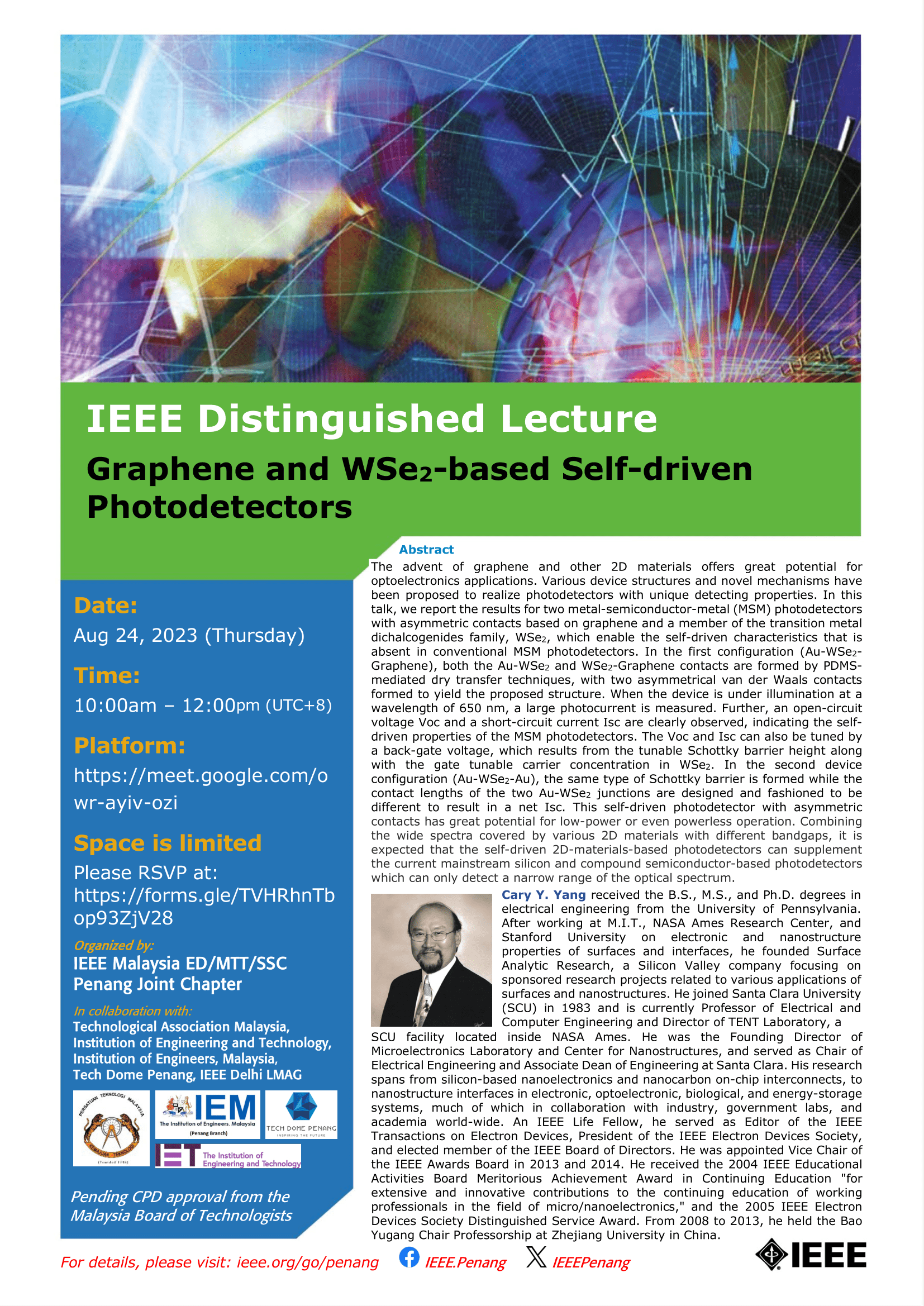[IEEEMY] Invitation to IEEE Distinguished Lecture – Graphene and WSe2-based Self-driven Photodetectors
Dear students,
The IEEE Malaysia ED/MTT/SSC Penang Joint Chapter is pleased to announce a Distinguished Lecture: Graphene and WSe2-based Self-driven Photodetectors by Cary Y. Yang.
Distinguished Lecturer: Cary Y. Yang, TENT Laboratory, Santa Clara University, USA.
Distinguished Lecture Title: Graphene And WSe2 -based Self-driven Photodetectors
Date: 24th August 2023 (Thursday)
Time: 10:00 am to 12:00 pm
Platform: Google Meet (https://meet.google.com/owr-ayiv-ozi)
Admission Free, all are invited to participate.
Registration link: https://forms.gle/TVHRhnTbop93ZjV28
E-certificate will be issued to the registered attendees only.
Abstract:
The advent of graphene and other 2D materials offers great potential for optoelectronics applications. Various device structures and novel mechanisms have been proposed to realize photodetectors with unique detecting properties. In this talk, we report the results for two metal-semiconductor-metal (MSM) photodetectors with asymmetric contacts based on graphene and a member of the transition metal dichalcogenides family, WSe2, which enable the self-driven characteristics that is absent in conventional MSM photodetectors. In the first configuration (Au-WSe2-Graphene), both the Au-WSe2 and WSe2-Graphene contacts are formed by PDMS-mediated dry transfer techniques, with two asymmetrical van der Waals contacts formed to yield the proposed structure. When the device is under illumination at a wavelength of 650 nm, a large photocurrent is measured. Further, an open-circuit voltage Voc and a short-circuit current Isc are clearly observed, indicating the self-driven properties of the MSM photodetectors. The Voc and Isc can also be tuned by a back-gate voltage, which results from the tunable Schottky barrier height along with the gate tunable carrier concentration in WSe2. In the second device configuration (Au-WSe2-Au), the same type of Schottky barrier is formed while the contact lengths of the two Au-WSe2 junctions are designed and fashioned to be different to result in a net Isc. This self-driven photodetector with asymmetric contacts has great potential for low-power or even powerless operation. Combining the wide spectra covered by various 2D materials with different bandgaps, it is expected that the self-driven 2D-materials-based photodetectors can supplement the current mainstream silicon and compound semiconductor-based photodetectors which can only detect a narrow range of the optical spectrum.
Speaker’s Biography:
image.png
Cary Y. Yang received the B.S., M.S., and Ph.D. degrees in electrical engineering from the University of Pennsylvania. After working at M.I.T., NASA Ames Research Center, and Stanford University on electronic and nanostructure properties of surfaces and interfaces, he founded Surface Analytic Research, a Silicon Valley company focusing on sponsored research projects related to various applications of surfaces and nanostructures. He joined Santa Clara University (SCU) in 1983 and is currently Professor of Electrical and Computer Engineering and Director of TENT Laboratory, a SCU facility located inside NASA Ames. He was the Founding Director of Microelectronics Laboratory and Center for Nanostructures, and served as Chair of Electrical Engineering and Associate Dean of Engineering at Santa Clara. His research spans from silicon-based nanoelectronics and nanocarbon on-chip interconnects, to nanostructure interfaces in electronic, optoelectronic, biological, and energy-storage systems, much of which in collaboration with industry, government labs, and academia world-wide. An IEEE Life Fellow, he served as Editor of the IEEE Transactions on Electron Devices, President of the IEEE Electron Devices Society, and elected member of the IEEE Board of Directors. He was appointed Vice Chair of the IEEE Awards Board in 2013 and 2014. He received the 2004 IEEE Educational Activities Board Meritorious Achievement Award in Continuing Education “for extensive and innovative contributions to the continuing education of working professionals in the field of micro/nanoelectronics,” and the 2005 IEEE Electron Devices Society Distinguished Service Award. From 2008 to 2013, he held the Bao Yugang Chair Professorship at Zhejiang University in China.
We look forward to your participation in this event.
Thank you.
Best Regards,
IEEE Malaysia ED/MTT/SSC Penang Joint Chapter
For details, please visit:
ieee.org/go/penang
https://www.facebook.com/IEEE.Penang


